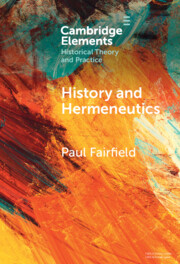Refine search
Actions for selected content:
4 results
Chapter 7 - History and historical inquiry
- from Part II - HASS concepts and sub-strands
-
-
- Book:
- Making Humanities and Social Sciences Come Alive
- Published online:
- 02 August 2025
- Print publication:
- 14 August 2025, pp 118-133
-
- Chapter
- Export citation

History and Hermeneutics
-
- Published online:
- 06 June 2025
- Print publication:
- 03 July 2025
-
- Element
- Export citation
Chapter 6 - Revisiting Gadamer’s Critique of Collingwood
- from Part I - Situating Collingwood: Beyond Idealism
-
-
- Book:
- Interpreting R. G. Collingwood
- Published online:
- 22 November 2024
- Print publication:
- 05 December 2024, pp 102-120
-
- Chapter
- Export citation
Chapter 4 - Approaches to historical thinking and learning
- from Part 2 - Planning for history teaching
-
-
- Book:
- Teaching Secondary History
- Published online:
- 15 October 2021
- Print publication:
- 22 November 2021, pp 79-99
-
- Chapter
- Export citation
